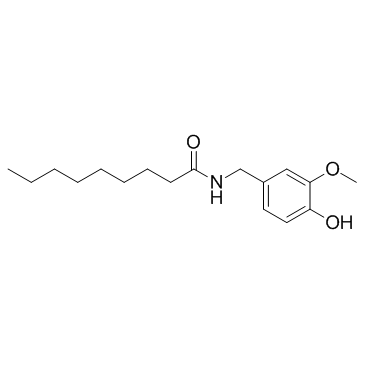Nonivamide

Nonivamide structure
|
Common Name | Nonivamide | ||
|---|---|---|---|---|
| CAS Number | 2444-46-4 | Molecular Weight | 293.401 | |
| Density | 1.0±0.1 g/cm3 | Boiling Point | 450.4±55.0 °C at 760 mmHg | |
| Molecular Formula | C17H27NO3 | Melting Point | 54°C | |
| MSDS | Chinese USA | Flash Point | 226.2±31.5 °C | |
| Symbol |

GHS07 |
Signal Word | Warning | |
|
Chemical genetics reveals a complex functional ground state of neural stem cells.
Nat. Chem. Biol. 3(5) , 268-273, (2007) The identification of self-renewing and multipotent neural stem cells (NSCs) in the mammalian brain holds promise for the treatment of neurological diseases and has yielded new insight into brain cancer. However, the complete repertoire of signaling pathways ... |
|
|
Identification and mechanosensitivity of viscerofugal neurons.
Neuroscience 225 , 118-29, (2012) Enteric viscerofugal neurons are interneurons with cell bodies in the gut wall; they project to prevertebral ganglia where they provide excitatory synaptic drive to sympathetic neurons which control intestinal motility and secretion. Here, we studied the mech... |
|
|
Nasal allergen deposition leads to conjunctival mast cell degranulation in allergic rhinoconjunctivitis.
Am. J. Rhinol. Allergy 28(4) , 290-6, (2014) The naso-ocular interaction in allergic rhinoconjunctivitis is well recognized from epidemiological, clinical, and experimental observations. The precise mechanisms remain incompletely understood. A new mouse model of allergic rhinoconjunctivitis was used to ... |
|
|
Hydrogen sulfide mediates hypoxia-induced relaxation of trout urinary bladder smooth muscle.
J. Exp. Biol. 209(Pt 16) , 3234-40, (2006) Hydrogen sulfide (H2S) is a recently identified gasotransmitter that may mediate hypoxic responses in vascular smooth muscle. H2S also appears to be a signaling molecule in mammalian non-vascular smooth muscle, but its existence and function in non-mammalian ... |
|
|
No direct association between asthma and the microbiome based on currently available techniques.
Medicine (Baltimore.) 93(27) , e199, (2014) Current uses of culture-independent tools in previous studies have shown a significant relationship between microbiota and asthma. Although these studies are relatively new, there is also evidence of the possibility of new therapeutic strategies for the treat... |
|
|
Analgesic topical capsaicinoid therapy increases somatostatin-like immunoreactivity in the human plasma.
Neuropeptides 48(6) , 371-8, (2014) The aim of the present study was to evaluate the therapeutic potential of local capsaicinoid (EMSPOMA(®) cream) treatment on chronic low back pain in patients with degenerative spine diseases and to investigate the possible mechanism of action of the therapy.... |
|
|
[Effect of cysteamine on vocalization responses by arterial algogenics in guinea pigs].
Nippon. Yakurigaku Zasshi. 91(1) , 55-9, (1988) Effects of cysteamine (2-mercaptoethylamine) on vocalization responses, a parameter of nociceptive response, was studied in conscious guinea pigs. Intra-arterial injection of bradykinin (3 micrograms), acetylcholine (300 micrograms), capsaicin (3 micrograms) ... |
|
|
[Effects of serial administration of vanillyl n-nonoylamide on vocalization responses by arterial algogenics in guinea pigs].
Nippon. Yakurigaku Zasshi. 85(6) , 481-6, (1985) Desensitizing effects of vanillyl n-nonoylamide, one of the synthetic capsaicinoids, were investigated by algogenics induced vocalization in conscious guinea pigs. Intra-arterial administration of bradykinin, acetylcholine and capsaicinoids (capsaicin, dihydr... |
|
|
Caged vanilloid ligands for activation of TRPV1 receptors by 1- and 2-photon excitation.
Biochemistry 45(15) , 4915-26, (2006) Nociceptive neurons in the peripheral nervous system detect noxious stimuli and report the information to the central nervous system. Most nociceptive neurons express the vanilloid receptor, TRPV1, a nonselective cation channel gated by vanilloid ligands such... |
|
|
Micturition in the unanesthetized rat: effects of intrathecal capsaicin, N-vanillylnonanamide, 6-hydroxydopamine and 5,6-dihydroxytryptamine.
Brain Res. 451 , 301, (1988) Unanesthetized rats chronically implanted with vesical and intrathecal catheters were injected intrathecally (i.t.) with either capsaicin (CAP), N-vanillylnonanamide (VN), 6-hydroxydopamine (6-OHDA), or 5,6-dihydroxytryptamine (5,6-DHT). The volume-evoked mic... |